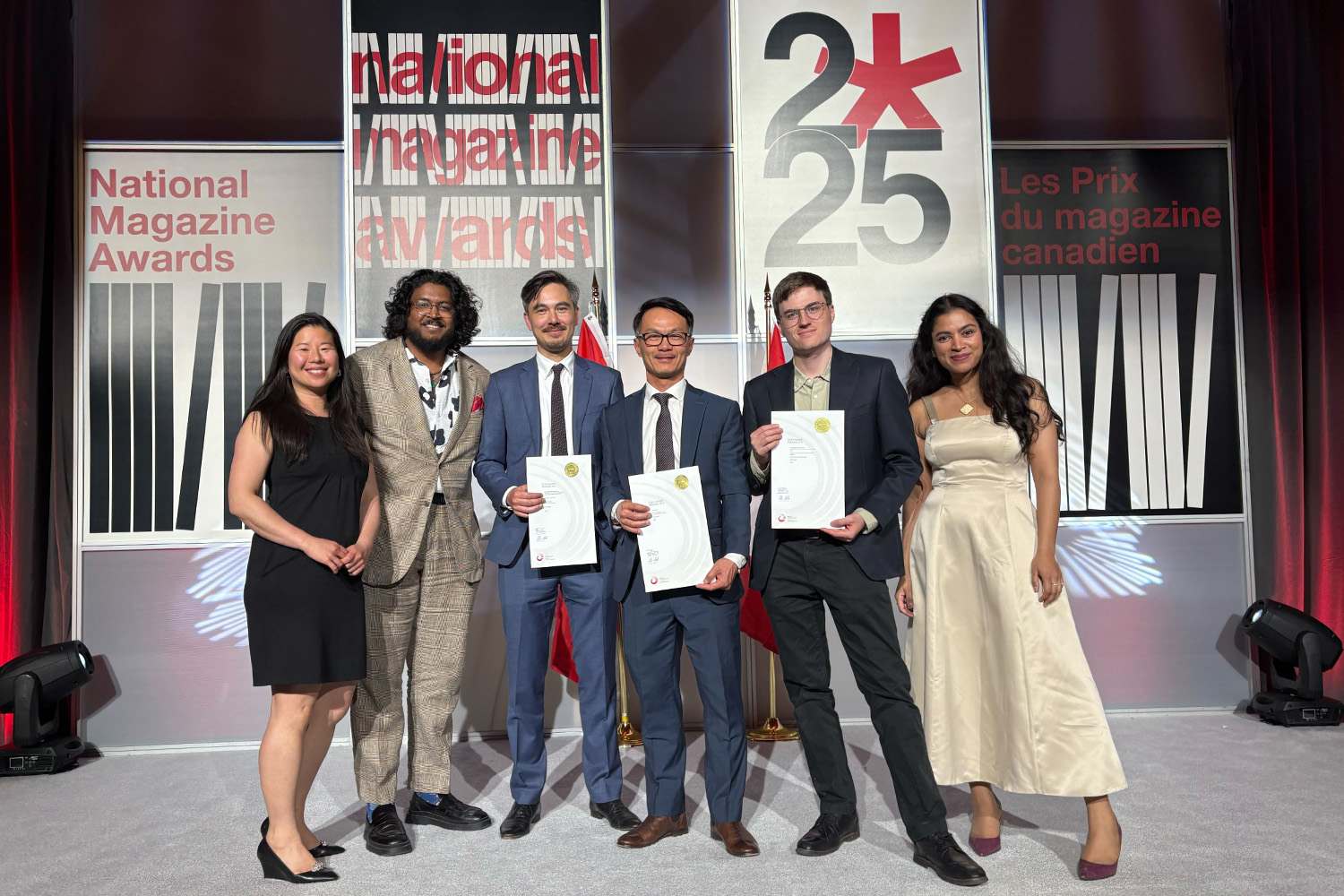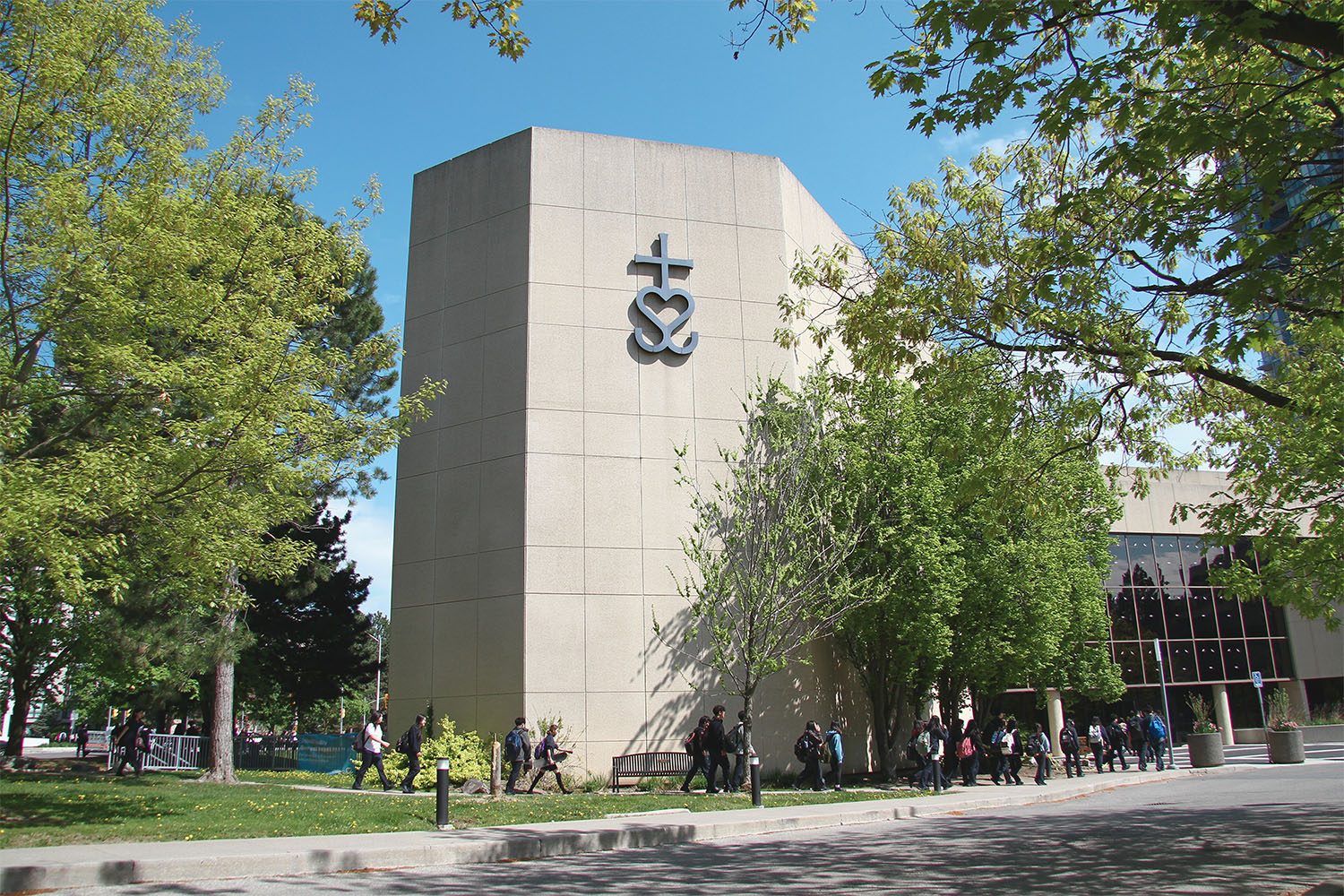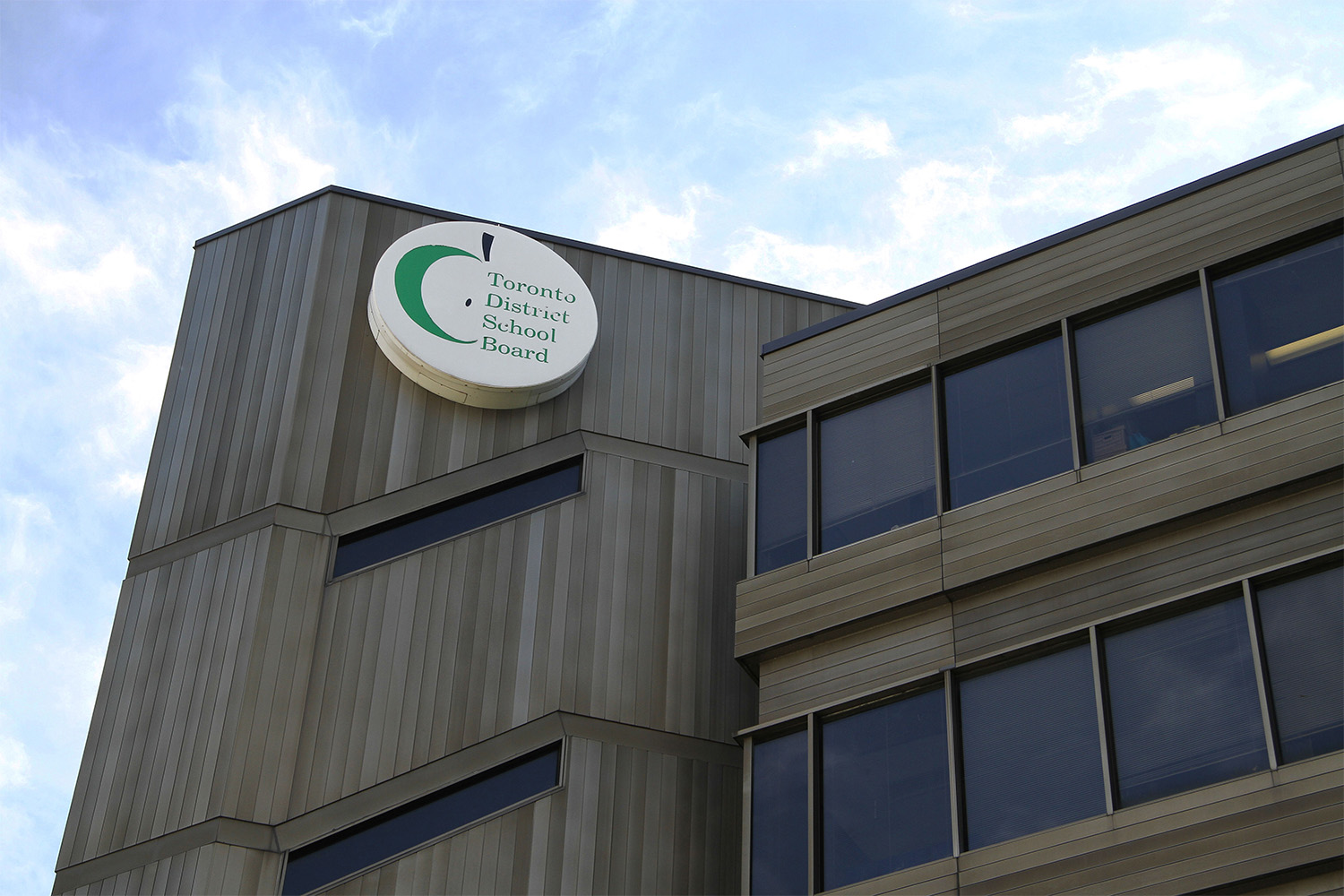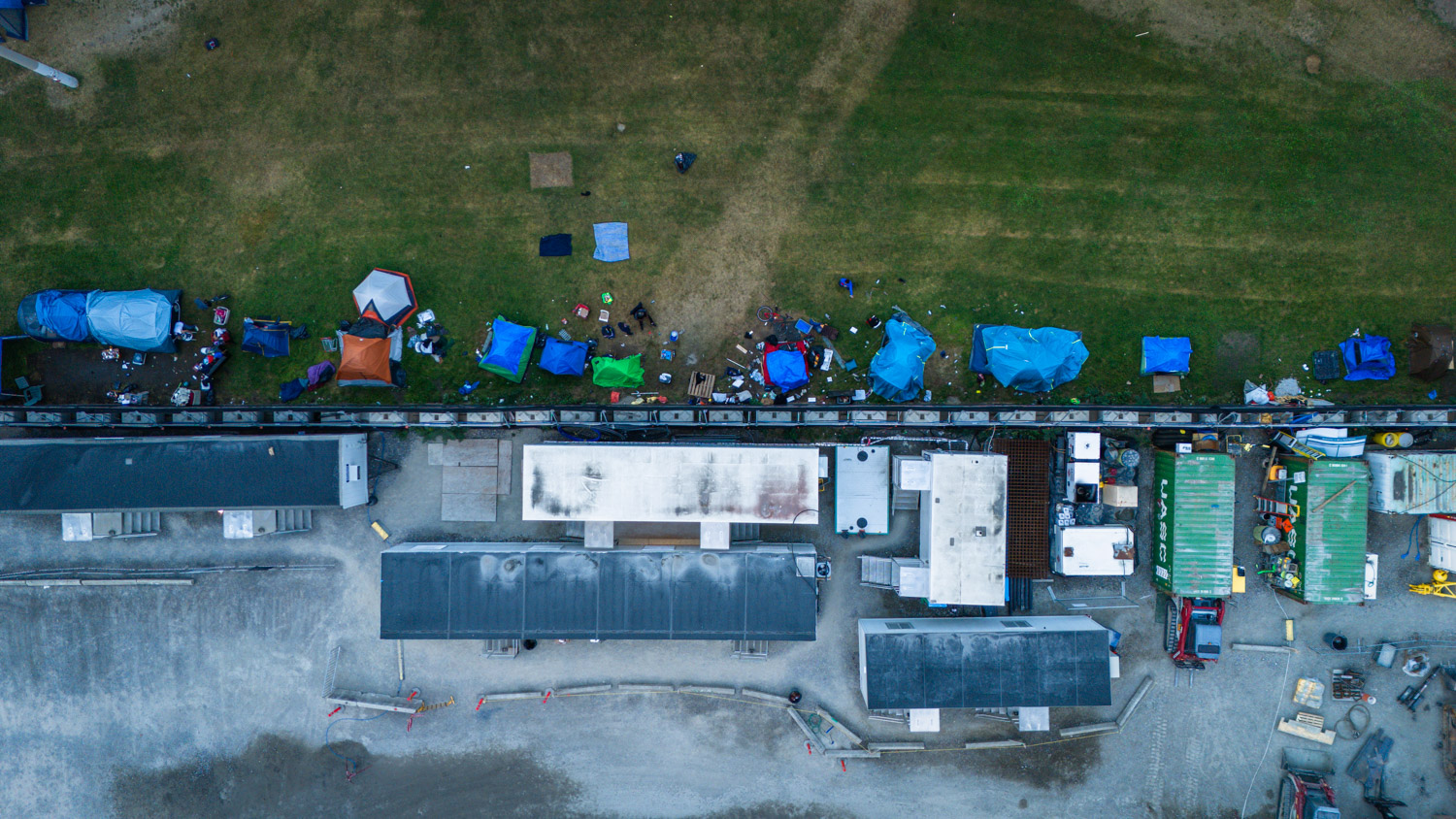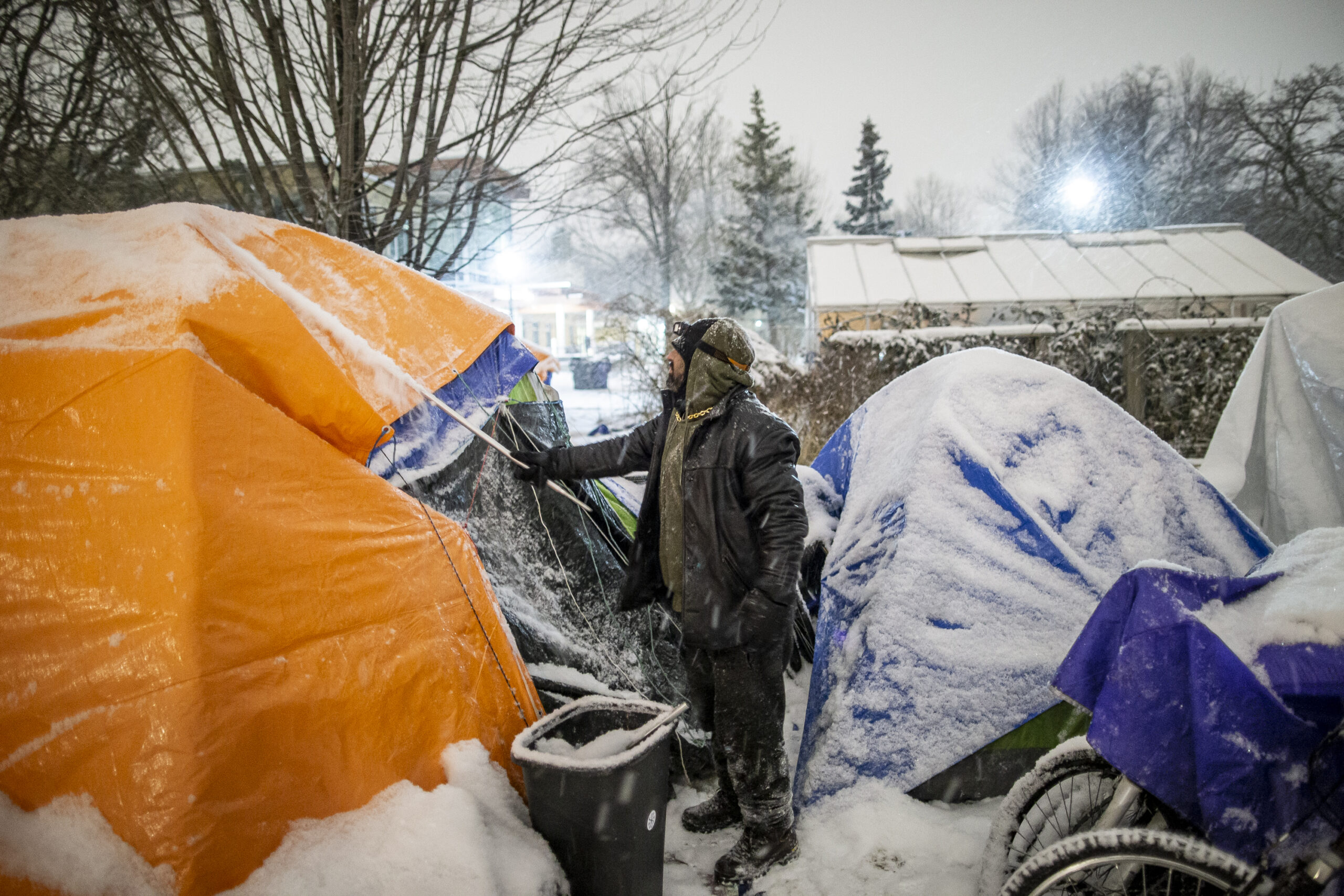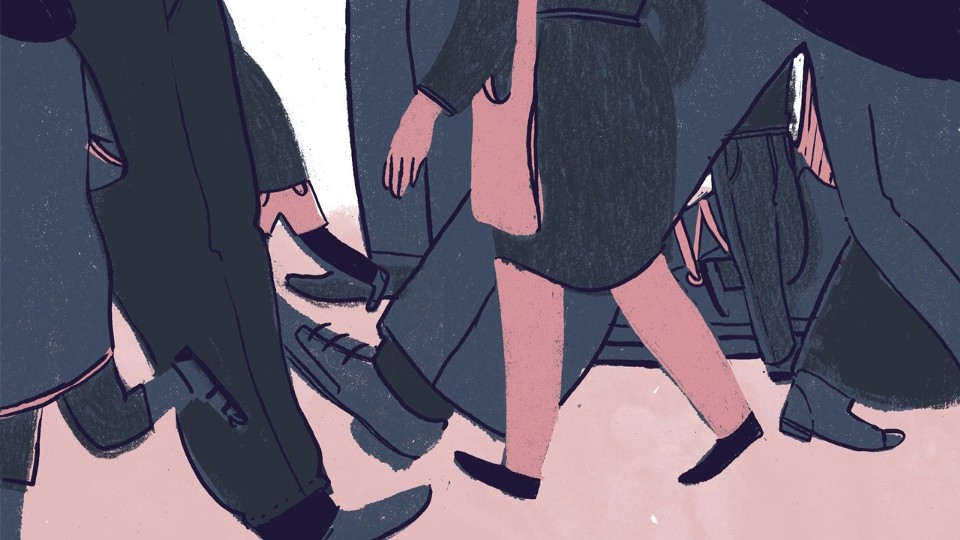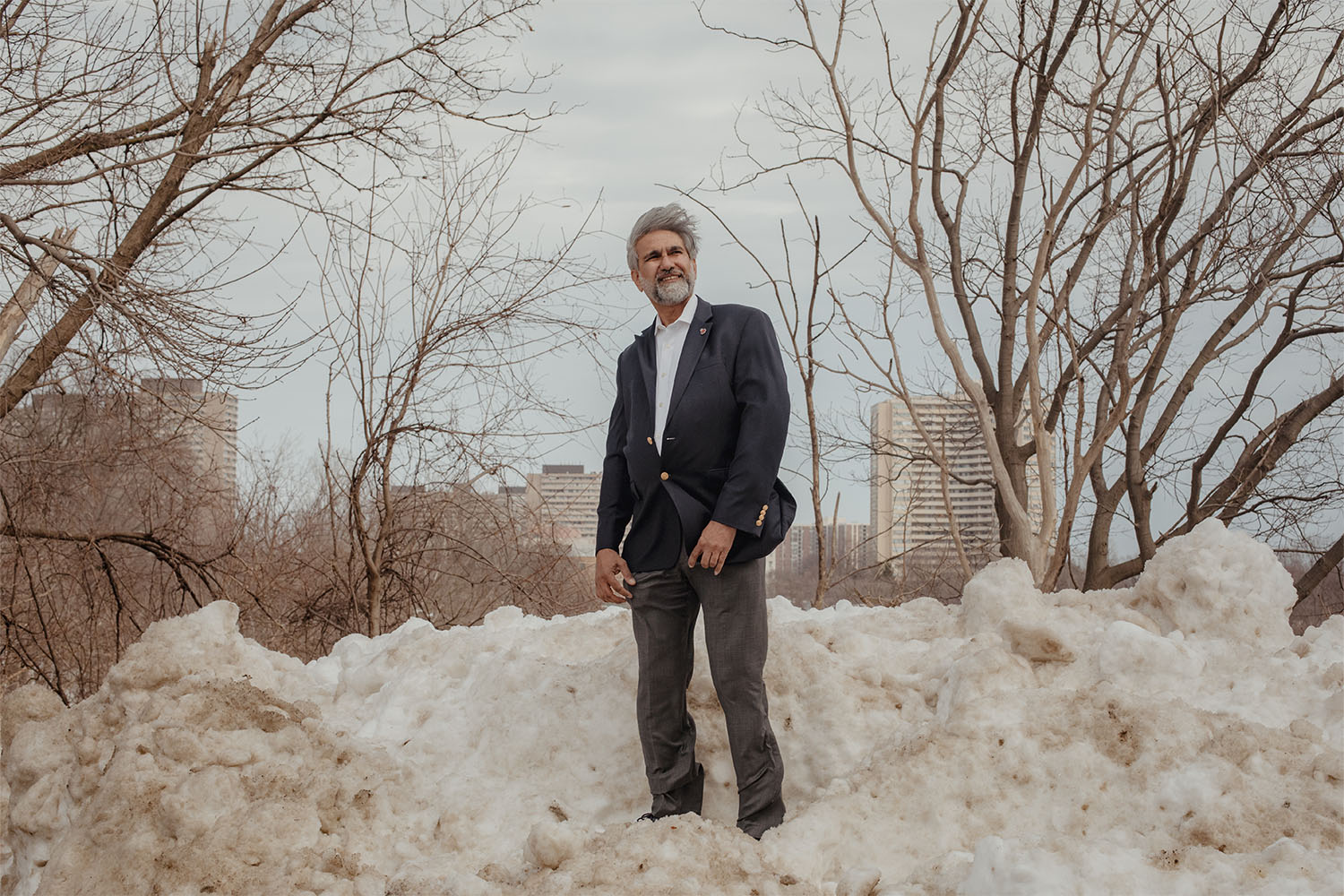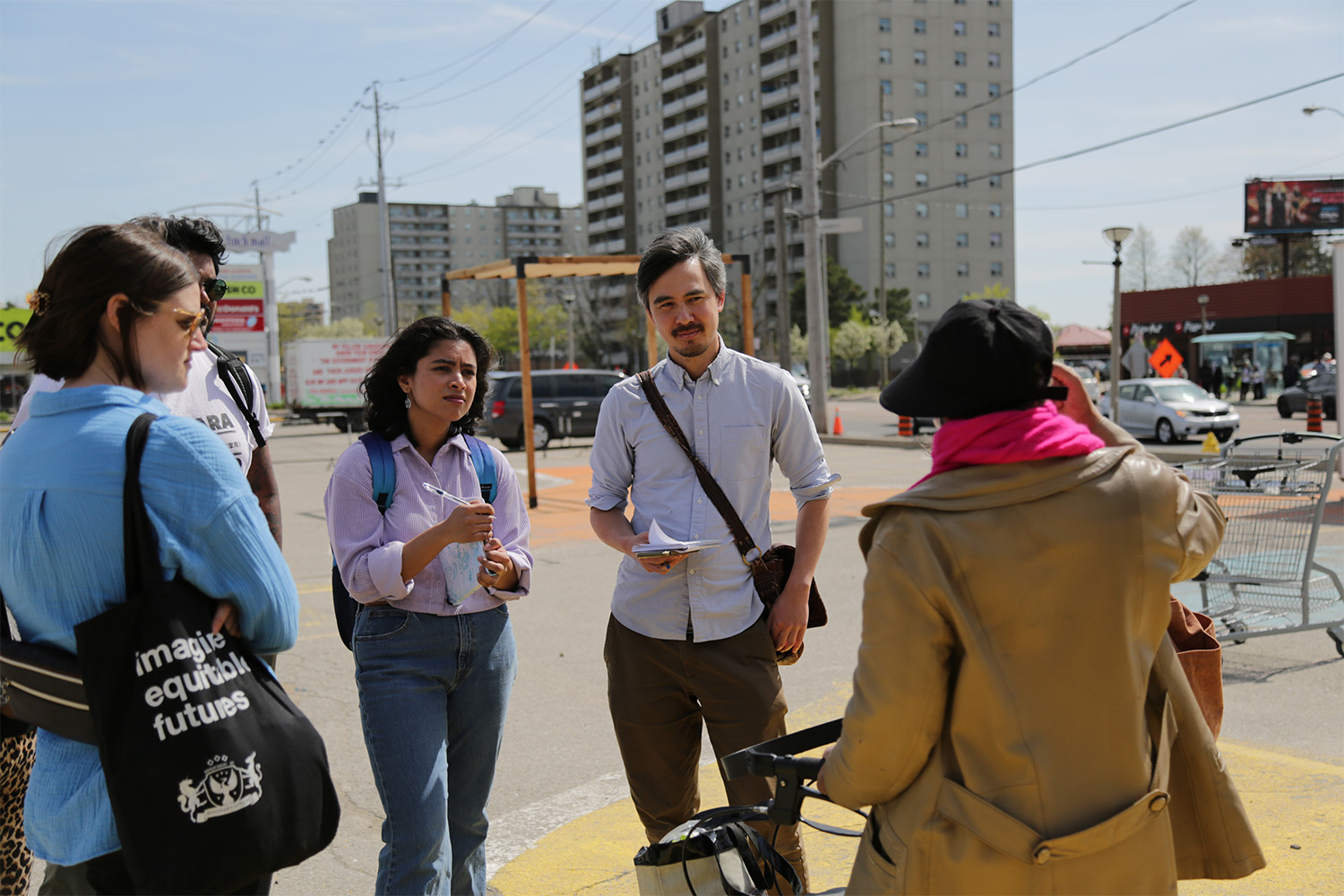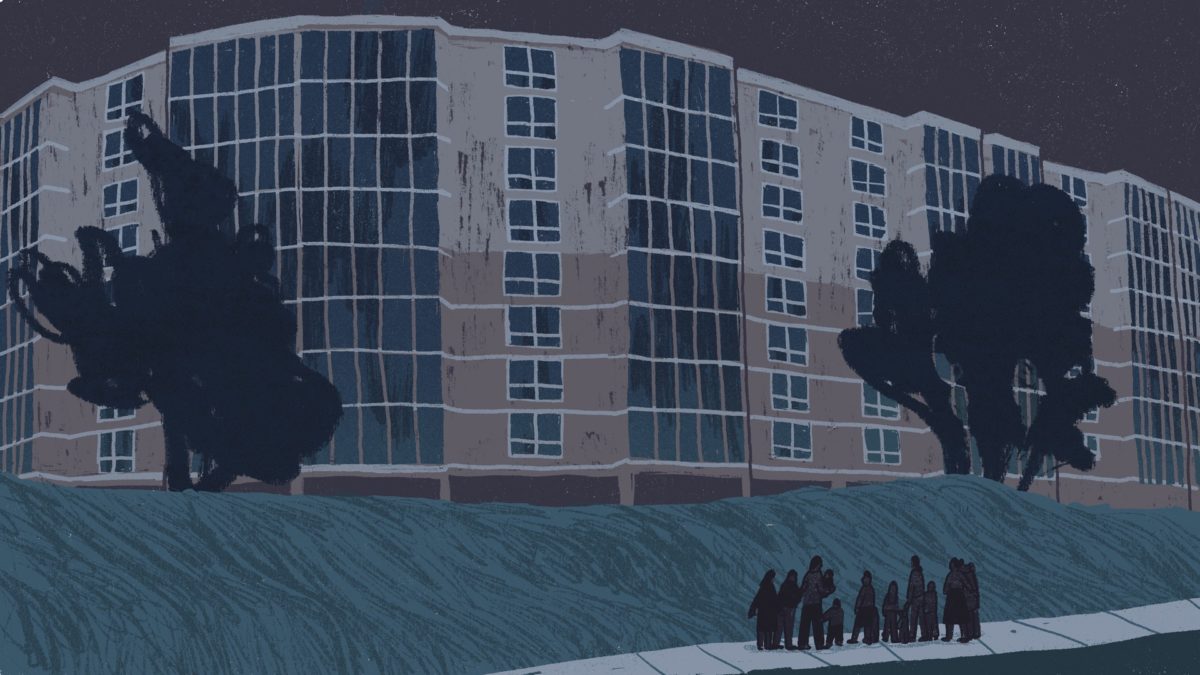
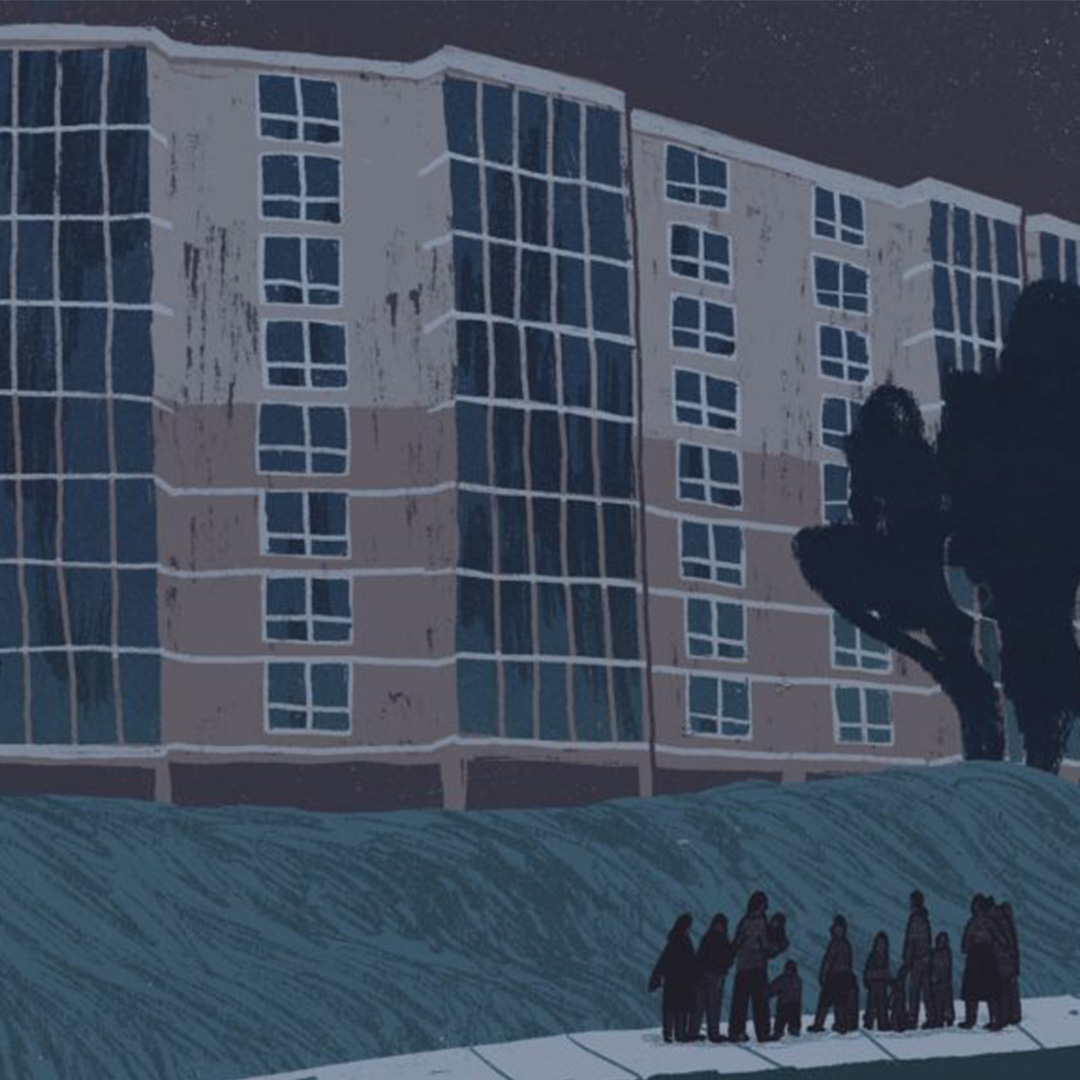
On a sunny morning in June, Jen Quinlan stood waiting on a corner in Toronto’s Flemingdon Park neighbourhood, scanning the street for any sign of the residents of 31–35 St Dennis Drive.
Quinlan is the director of health services at Flemingdon Health Centre, a collection of gently aging doctor’s offices and waiting rooms grafted onto the first floors of an apartment tower near Don Mills and Overlea. The daughter of a small-town Alberta nurse and doctor, the dark-haired 35-year-old is a true believer in community health — someone who goes to workshops about intersectionality on her days off and dutifully orders one of the rare vegetarian options at the neighbourhood’s Turkish restaurant because she believes, strongly, in supporting local businesses.
That morning, she was accompanied by Cole Webber, a legal clinic worker from Parkdale. Their plan was simple: bring busloads of tenants to the gleaming corporate headquarters of The Minto Group, the apartment’s landlords. Then, demand a meeting with whoever was in charge and deliver a petition insisting on an end to proposed rent hikes — a not-so-subtle show of force to let Minto know that the tenants would not be pushed around. Quinlan had booked two yellow school buses for the journey. Now she just needed to fill them.
Helping lead a guerrilla protest against a corporate landlord wasn’t something that naturally fell into a public health worker’s job description, but Quinlan was jumping into the task with characteristic enthusiasm, greeting each new potential protestor like a bubbly party host. The bus trip was the result of months of conversations and town hall meetings with the community about their housing concerns. The key, now, was for the tenants to present a united front. But as the 9:15 departure time came and went, just four residents had gathered.
It wasn’t hard to figure out who was missing. In the last few years, the composition of both the building and the neighbourhood had changed dramatically. Today, nearly half of the residents of 31–35 St Dennis Drive are Roma — part of a wave of asylum seekers from Slovakia and the Czech Republic who have arrived in Toronto over the last five years and settled, seemingly invisible to the rest of the city, in just a handful of apartment buildings in Flemingdon and Thorncliffe Park. Quinlan had spent years working to build trust with the community. This protest had grown, slowly and circuitously, out of her attempt to improve the health of the new arrivals. But as the morning wore on and the streets remained empty, it increasingly looked like the Roma weren’t coming.
To begin with — before sparking a public battle between an apartment full of low-income refugee claimants and one of the wealthiest real estate companies in Canada — Jen Quinlan was just trying to figure out how to get some kids to go to the dentist.
It was the fall of 2015 and the staff at Flemingdon Health Centre had noticed a troubling pattern. In appointment after appointment, parents were bringing them forms from the local school that said that their children hadn’t followed through on their immunizations and dental screenings. It wasn’t just a few families — it was dozens of parents, each casually passing on frustrating evidence that they’d simply neglected to provide their kids with free and vital health care. Finally the schools themselves began calling. “They approached us and said, ‘What can we do? We think all these people are your clients,’” Quinlan remembers.
In some ways, the issue was simple: the families didn’t speak English, couldn’t read the forms, and so treated them as yet more pieces of paper in an endless shuffle of inconsequential field trip permissions and school announcements. As Quinlan thought more about the problem, however, its dimensions seemed to grow. Why wasn’t anyone able to read English? Didn’t they have trusted community members who could tell them how important these health visits were? How was it possible that so many of her clients were falling through the cracks?
The clients were Roma refugee claimants — members of an ethnic group often called Gypsies, though the term is now considered pejorative. The families had begun arriving around 2012, primarily from Slovakia, with smaller numbers from the Czech Republic. A trickle of arrivals had become a rush. And the vast majority had settled in the neighbourhood served by Quinlin’s community health centre. Today, Flemingdon Health Centre serves about 2,000 Roma clients, a full twenty percent of their patients.
The clinicians at the centre are used to treating low-income immigrant families. But providing care to the Roma presented specific challenges. First, they had never worked with a population that was so new. Unlike, say, an Ismaili Muslim from Afghanistan — who arrives in Toronto and enters an established community, with a network of people who have been here for decades — the Slovak Roma families were a population without roots in Canada. Roma asylum seekers from Hungary had arrived in the 2000s, mostly settling in Parkdale, but they were an entirely different community, and many had since been deported. The most established Slovak Roma Quinlan was able to find had only been here since 2011. “If the first wave is someone who has only been here for seven years and is still living in poverty, still experiencing lots of barriers to employment, that’s not necessarily someone who has a lot of social capital to help the person who’s been here a month,” says Quinlan.
Flemingdon Park has long been one of this city’s landing strips — a spot for successive waves of immigrants to touch down, find an apartment, and begin a new life.
Beyond their newness, there were other characteristics that made the Roma population distinct. John Ihnat, a staff physician at Health Access Thorncliffe Park, noticed that Roma patients often came in complaining of pain and physical ailments that, over time, were revealed to have their root in trauma or mental illness. “Post-traumatic stress disorder, anxiety, and depression seem quite dominant,” says Ihnat. The community suffered from a huge number of untreated chronic conditions. Doctors found a higher than normal number of auditory problems. Cochlear implants were unusually common, and Quinlan began to suspect that the problem stemmed from the fact that, incredibly, her clients hadn’t been treated for simple ear infections when they were children. Taken as a whole, the Roma families she spoke with seemed to have existed entirely outside of social services in their home countries.
Quinlan is an enthusiastic patient advocate, someone who strides through the halls of the health centre wielding her smile like a scythe, determined to cut through any grumbling and naysaying with brute positivity. But the question of how to help the Roma population weighed on her. “I’ve never experienced anything like it,” Quinlan says. “I’ve worked in five priority neighborhoods. I’ve worked with a ton of newcomer populations. And this really does feel different to me. Remarkably different.”
Flemingdon Park has long been one of this city’s landing strips — a spot for successive waves of immigrants to touch down, find an apartment, and begin a new life. Tucked between the two branches of the Don River just south of Eglinton, the neighbourhood is a dense collection of ill-kept, post-war apartment buildings. Flemingdon and neighbouring Thorncliffe Park have more visible minorities than any other neighbourhoods in the Toronto Central LHIN. Nearly 70 percent of the population speaks a mother tongue other than English — the nearby foodmart filled with the sounds of Urdu and Gujarati, Farsi and Tagalog.
When Miroslav Mizikar landed in Toronto on a cold day in March, 2017, he didn’t know anything about Flemingdon Park. He didn’t know anything about the city in general, beyond the scraps he’d heard from a friend who had moved here a few years earlier: that it was a place where someone who was Roma could not only survive, but thrive.
A handsome 19-year-old with bright eyes and a quiet charisma, Mizikar had come from the Czech Republic with his parents, his younger sister, and his fiancée, Natalia Pistolova. After applying for refugee status, the family moved in with a friend for a few days, then spent two months in a family shelter in Newmarket. While he was there, he began seeking out other Roma people in Toronto on Facebook. And nearly everyone he messaged said the same thing: they were living in Flemingdon Park. More specifically, they were living in a single building — 31–35 St Dennis Drive, a hulking ten-story low-rise just off the Don Valley. In the summer of 2017, Mizikar and his family found a spot and moved in.
The apartment was crowded — an ill-kept two-bedroom in an aging building — but Flemingdon immediately felt like home. For Mizikar, growing up in the town of Hulin in the Czech Republic had meant surviving in an atmosphere of constant hostility. His father, an auto mechanic and bricklayer, applied for job after job, only to be rejected after employers learned he was Roma. One day, just before his twelfth birthday, Mizikar went to the park with his friends when three men suddenly appeared. While his friends scattered, the men held him back and kicked him, then threw him to the ground and kicked him some more. “When you are born Roma in my country, you have a very hard life,” Mizikar says. “Better to be born a dog. At least you have food and people take care of you.”
The discrimination Mizikar experienced wasn’t just the result of a handful of racist thugs. In both the Czech Republic and Slovakia, systemic racism against the Roma is widespread and deep-rooted. The Roma are an ethnic group without a nation — an itinerant population without a written history. Recent genetic studies have traced the Roma to Northern India, but exactly how or why the group ended up in eastern Europe 1,500 years ago is unclear. They’re the largest single ethnic minority group in Europe, yet they’ve remained remarkably apart and, beneath the lazy stereotypes about Gypsy fortune tellers and caravans, entirely misunderstood.
Recent reports by Amnesty International have found that authorities in both the Czech Republic and Slovakia segregate Roma children from the rest of the population, placing them in Roma-only classrooms or schools for pupils with “mild mental disabilities.” Romani women in the Czech Republic have been the victims of involuntary sterilization. The anti-Roma discrimination Mizikar experienced in the streets is mirrored at the highest levels of society. There have been multiple reports of police violence against Roma settlements in Slovakia. Last year, in the run-up to his country’s election, Czech President Miloš Zeman casually declared that 90 percent of his country’s “unadaptable” citizens are probably Roma. He won re-election easily.
When Mizikar arrived in Canada, then, it was after twenty years in a country in which his people were badly educated, excluded from the workforce, and poorly treated by health and social services. In Canada, walking through the mall with his fiancée or asking for directions on the street, he was constantly surprised by the way people spoke to him. “When I came here and white people were helping me, it was shocking,” he says. “Because in my country, white people have been killing the Roma.”
In Flemingdon Park, Mizikar saw people like Quinlan trying to reach out to Roma families. And he saw members of his community refusing to engage. At the local library, branch head Adele Lamphier struggled to create programming for the growing number of Roma kids who were visiting her library, often without their parents. “We didn’t know what to do,” says Lamphier. “All of our traditional approaches weren’t working.” The kids all seemed to like to dance, so Lamphier created a dance program. Nobody came. Indeed, whenever she tried anything too structured, too directed, the kids would simply disappear.
For Mizikar, the reaction was predictable. His people didn’t trust outsiders — a wariness formed over generations that couldn’t be changed with a couple of dance classes. “Sometimes, people are offering free programs and good things,” says Mizikar. “But they don’t know how to inform this community. Because this community is very careful with someone who is not Roma.”
At the Flemingdon Health Centre, Quinlan brought in a Toronto Public Health nurse who spoke Slovak to work with the parents. The problems with children’s vaccination and dental visits were quickly resolved. “But once we addressed that, we realized that that was just such a small part of the settlement,” says Quinlan. The Roma were suddenly a fifth of her clients and, at a fundamental level, the community health centre wasn’t able to help them with their biggest problems.
The first hurdle was simply communication. The families spoke Romani, but there were no official Romani interpreters in the system. In fact, because Romani is not historically a written language, translation services had no way of certifying a Romani interpreter. When doctors saw patients, they would use an interpreter who spoke Czech or Slovak, often a speaker’s second or third language after multiple Romani dialects. It was a language that usually held negative connotations. It was also one in which many clients were illiterate, making written forms next to useless.
The more Quinlan learned about the community, the more she understood the massive barriers that stood between them and accessing health care. When it came to the social determinants of health — the way that things like race and education, social exclusion and income all come together to influence someone’s wellness — the Roma seemed to tick all the boxes. “When I speak to our clients, it’s mindboggling how many of those system challenges come together in one family,” says Quinlan.
Last year, the Flemingdon Health Centre received a grant from the city to hire members of the Roma community to act as outreach workers. The health centre needed to gain trust, and what better way to show that they were truly invested in the community than to hire some of their own? One of the first people to apply was Miroslav Mizikar.
Since arriving in Canada, Mizikar had been busy trying figure out how to build a life for himself and his growing family. Those first few months, he spent days listening to English music and watching Baywatch or Fifty Shades of Grey — anything to improve his language skills. He already spoke Romani, Czech, and Slovak and he found that English came relatively easily. By late 2017, he and Pistolova were expecting their first child. When they visited the health centre for a prenatal check-up, their doctor gave them a flyer announcing the new positions.
The hiring process was atypical. Mizikar did his interview through an interpreter. Quinlan worked with him to get his work permit, delaying the grant until his papers came through. Finally, at the end of 2017, Mizikar began work as the project coordinator of the “Resiliency in Roma Communities Project.”
“When I started working, the people were in shock,” says Mizikar. “They don’t understand how this guy has learned English so quickly, how he knows how to fill out the forms.” Today, Mizikar is constantly busy. He accompanies families to the hospital and visits them at home. He acts as an interpreter and advocate, speaking to the community in their own language and helping them navigate the idiosyncratic bureaucracies of their new country.
Recently, he learned that one of the interpreters on the language line — a Slovak speaker on the phone from London, England — had been injecting racist commentary into the interactions between doctor and patient. At a meeting at the health centre in June, when he told the gathered doctors and nurses, there were audible gasps. The information squared with what they had experienced in their appointments, where an innocuous medical suggestion, when translated, would be met with confusion or anger.
Mizikar was a signal, in human form, that the health centre was serious about helping the Roma population. But to Quinlan it still often felt like they weren’t connecting. Patients might nod agreeably when a doctor suggested a course of action, but at the next meeting the physicians would find they’d been completely ignored. What seemed to doctors like a vital prescription or medical screening was put aside as families dealt with other worries — things like employment, refugee hearings or, increasingly, housing issues.
Last winter, the clinic’s Tuesday afternoon drop-in had become an ad hoc housing clinic. “So many people were coming with their eviction notices, with their above-guideline rent increases, with the fact that they had no heating, with the fact that there were leaks,” says Quinlan. And the vast majority of complaints came from 31–35 St Dennis.
The building had recently been bought by the Minto Group — a massive real-estate company that manages 13,000 multi-residential units across Canada and whose founders are the 74th richest people in Canada according to Canadian Business. Flemingdon is a low-income neighbourhood, but with the Eglinton Crosstown LRT set to be completed in a few years it seemed inevitable that rents in the area would rise. Tenants said Minto had invested in the lobby and the exterior of the building while ignoring calls to fix their units. Mizikar took pictures of various units in disrepair, with crumbling showers, splintered floors, and broken windows left open to the bitter cold. “The landlord’s position has been that they will evaluate the unit and they will determine whether the repairs are needed,” says Minto spokesperson John Dickie. “People are not entitled to cosmetic upgrades.” Dickie doesn’t dispute that during the cold snap last winter the building didn’t have heat for nearly a week. Now Minto was asking for a rent increase of 4.8 percent, well above the 1.8 percent provincial guideline, in order to pay for their investments in the building.
Over the course of 2018, Quinlan began the process of learning how to be a housing advocate. She contacted Cole Webber and Kevin Laforest, lawyers who had helped organize the Parkdale rent strikes of 2017, which had won significant concessions from corporate landlords. Miroslav Mizikar met with tenants, explaining that their actions would not affect their refugee hearings, that their housing situation could only improve if they acted together.
“If we’re going to try to help folks, we need to build trust,” Quinlan reasoned. “Part of that is to actually address the things that are most pressing to these communities. And housing seems to be on everyone’s list.”
The morning of the bus trip in June, as Quinlan stood waiting on the streets of Flemingdon, Mizikar was nowhere to be seen. Pistolova was pregnant with their second child and that morning they were both at the hospital. And without Mizikar, it was like a silent signal had been broadcast across the neighbourhood. Quinlan walked over to 31–35 St Dennis to try to round up tenants and returned ten minutes later, alone. She had found plenty of Roma families who said they really supported their actions, she said. They just all said they were busy that day.
“I’ve worked in five priority neighborhoods. I’ve worked with a ton of newcomer populations. And this really does feel different to me. Remarkably different.”
Finally, after an hour, Quinlan had to make the call: the Roma weren’t coming. Quinlan, Webber, and the four tenants boarded the bus and drove north to Minto’s offices. They were hustled into a board room with Martin Tovey, vice president of investments, a broad-shouldered, goateed executive wearing a polo shirt from “Latitude Margaritaville,” Minto’s series of retirement communities inspired by “the music and lifestyle” of Jimmy Buffett.
In the austere corporate setting, any righteous anger the small group might have felt seemed to shrink. “I’m not sure what it is you’re looking to me for,” Tovey told the group. The tenants began to explain. The rent hikes, they said, were too much for them. The building was in disrepair. Last winter they had been without heating for a week. “But we fixed that,” said Tovey. Finally, Rehan Mirza, an immigrant from Pakistan who has lived at St Dennis for 8 years, presented Tovey with the petition — 128 signatures demanding Minto “withdraw all pending rent increases.”
On the ride back to Flemingdon, Quinlan tried to keep the energy up. “Congratulations, I think that went really well,” she said cheerily. “How did you feel?”
But the trip had underlined the difficulty of the kind of work she and the rest of the workers at the Flemingdon Health centre were taking on. The entire philosophy behind the community health centre — the approach to medicine that Quinlan was so passionate about — was about not simply treating a client’s illness, but trying to change the factors that made them sick. At times, though, it seemed as if just making sure the kids in the neighbourhood went to the dentist and got their vaccinations was difficult enough. Working with a community on housing, removing language barriers, understanding past traumas and prejudices, building a foundation of trust — that was a job that had no end.
By August, the housing battle had become a full-fledged rent strike, with 200 tenants agreeing to withhold rent until Minto gave up on their above-guideline rent increases. (According to Minto, just 50 units withheld rent in August). The strike earned headlines across the country — the latest example of a low-income community taking collective action against a corporate landlord. “We’re in an affordable housing crisis in the greater Toronto area,” said the lawyer Kevin LaForest. “People are being displaced because landlords are trying to maximize profits.”
The landlord’s position has held firm. “Minto has put almost 6 million dollars of major repairs into the project,” says Dickie. “New heating system and improvements for the hot water heating. They have put in security systems, cameras. They have improved many aspects of the building. That work needs to be paid for.” On August fourth, they sent papers to tenants starting the eviction process.
Mizikar became the face of the strike and the voice of the community. Each day he knocked on doors, reassuring families who were going through refugee hearings that they had rights as tenants in Canada. He was stressed. His blood pressure, he said, had gone up. Living at 31–35 St Dennis meant never being able to leave his work. In his home country, for a Roma person to know someone like him, a person with the slightest bit of institutional power, was “like a miracle.” At St Dennis he received dozens of visits a day — people knocking on his door, asking him for help.
Mizikar was exhausted. But he was proud of the work. The rent strike, he said one day in mid-August, was making a difference. “The landlord now wants to hear from the tenants,” said Mizikar. They were beginning a dialogue, slowly fixing things that hadn’t been fixed before. And the relationship between the Roma and the health team in their neighbourhood was improving, however slowly and tentatively. “The Roma community does not trust anyone,” said Mizikar declaratively, before correcting himself. “The Roma community does not trust anyone until that person shows them that they want to help.” Jen Quinlan and the Flemingdon Health Centre team were still trying to show them.

